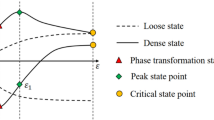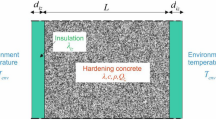Abstract
The thermal conductivity of nacre from red abalone (Haliotis fulgens) has been determined as a function of temperature (2–300 K), direction, and treatment to partially demineralize or to remove a portion of the organic matrix. The room-temperature thermal conductivity and specific heat of nacre are ∼1 W m−1 K−1 and 0.9 J K−1 g−1, respectively. The thermal conductivity of nacre is rather low and glass-like. It is not as anisotropic as one might expect on the basis of brick-and-mortar structure, in support of recent findings that the aragonite tablets are not monolithic. Partial removal of the mineral component reduces the thermal conductivity in both principal directions, whereas partial removal of the proteins (as observed by 13C NMR) only reduces the thermal conductivity across the aragonite layers.










Similar content being viewed by others
References
B.J.F. Bruet, H.J. Qi, M.C. Boyce, R. Panas, K. Lai, L. Frick, and C. Ortiz: Nanoscale morphology and indentation of individual nacre tablets from the gastropod mollusc Trochus niloticus. J. Mater. Res. 20, 2400 (2005).
M. Rousseau, E. Lopez, P. Stempflé, M. Brendlé, L. Franke, A. Guette, R. Naslain, and X. Bourrat: Multiscale structure of sheet nacre. Biomaterials 26, 6254 (2005).
A.P. Jackson, J.F.V. Vincent, and R.M. Turner: The mechanical design of nacre. Proc. R. Soc. Lond. B Biol. Sci. 234, 415 (1988).
A.Y. Lin and M.A. Meyers: Interfacial shear strength in abalone nacre. J. Mech. Behav. Biomed. Mater. 2, 607 (2009).
A.G. Checa and A.B. Rodríguez-Navarro: Self-organization of nacre in the shells of Pterioida (Bivalvia: Mollusca). Biomaterials 26, 1071 (2005).
P.U.P.A. Gilbert, R.A. Metzler, D. Zhou, A. Scholl, A. Doran, A. Young, M. Kunz, N. Tamura, and S.N. Coppersmith: Gradual ordering in red abalone nacre. J. Am. Chem. Soc. 130, 17519 (2008).
R. Knitter, C. Odemer, and J. Hausselt: Thermal investigations on abalone nacre. CFI-Ceramic Forum International 85, E38 (2008).
F. Barthelat, C.-M. Li, C. Comi, and H.D. Espinosa: Mechanical properties of nacre constituents and their impact on mechanical performance. J. Mater. Res. 21, 1977 (2006).
C. Jäger and H. Cölfen: Fine structure of nacre revealed by solid state 13C and 1H NMR. CrystEngComm. 9, 1237 (2007).
B. Pokroy, J.S. Fieramosca, R.B. Von Dreele, A.N. Fitch, E.N. Caspi, and E. Zolotoyabko: Atomic structure of biogenic aragonite. Chem. Mater. 19, 3244 (2007).
M. Darder, P. Aranda, and E. Ruiz-Hitzky: Bionanocomposites: A new concept of ecological, bioinspired, and functional hybrid materials. Adv. Mater. 19, 1309 (2007).
M.E. Launey and R.O. Ritchie: On the fracture toughness of advanced materials. Adv. Mater. 21, 2103 (2009).
R.A. Metzler, J.S. Evans, C.E. Killian, D. Zhou, T.H. Churchill, N.P. Appathurai, S.N. Coppersmith, and P.U.P.A. Gilbert: Nacre protein fragment templates lamellar aragonite growth. J. Am. Chem. Soc. 132, 6329 (2010).
A. Lin and M.A. Myers: Growth and structure in abalone shell. Mater. Sci. Eng. A 390, 27 (2005).
R. Menig, M.H. Meyers, M.A. Meyers, and K.S. Vecchio: Quasi-static and dynamic mechanical response of Haliotis rufescens (abalone) shells. Acta Mater. 48, 2383 (2000).
J.S. Huang, K.J. Lin, and C. Tien: Measurement of heat capacity by fitting the whole temperature response of a heat-pulse calorimeter. Rev. Sci. Instrum. 68, 94 (1997).
C.A. Kennedy, M. Stancescu, R.A. Marriott, and M.A. White: Recommendations for accurate heat capacity measurements using a Quantum Design physical property measurement system. Cryogenics 47, 107 (2007).
O. Maldonado: Pulse method for simultaneous measurement of electric thermopower and heat conductivity at low temperatures. Cryogenics 32, 908 (1992).
M.B. Jakubinek, C.J. Samarasekera, and M.A. White: Elephant ivory: A low thermal conductivity, high strength nanocomposite. J. Mater. Res. 21, 287 (2006).
O. Gómez, P. Quintana, D.H. Aguilar, J.J. Alvarado-Gil, M. Yánez-Limón, L. Diaz, and D. Aldana: Photothermal characterization of materials biomineralized by mollusks. Rev. Sci. Instrum. 74, 750 (2003).
M.A. White: Physical Properties of Materials (CRC Press, Boca Raton, FL, 2011).
C. Clauser and E. Huenges: Thermal conductivity of rocks and minerals. In Rock Physics and Phase Relations: a Handbook of Physical Constants; T.J. Aherns, ed.; American Geological Union, Washington, DC, (1995).
T.R. Tuladhar, W.R. Paterson, and D.I. Wilson: Investigation of alkaline cleaning-in-place of whey protein deposits using dynamic gauging. Food Bioprod. Process. 80, 332 (2002).
L.A.K. Staveley and R.G. Linford: The heat capacity and entropy of calcite and aragonite, and their interpretation. J. Chem. Thermodyn. 1, 1 (1969).
T.M. Tritt: Thermal Conductivity: Theory, Properties and Applications (Kluwer/Plenum, New York, 2004).
G. Chen: Phonon heat conduction in nanostructures. Int. J. Therm. Sci. 39, 471 (2000).
Y-Y Hu K Schmidt-Rohr (2009) ArticleTitleEffects of L-spin longitudinal quadrupolar relaxation in S{L} heteronuclear recoupling and S-spin magic-angle spinning NMR J. Magn. Reson. 197 193 Occurrence Handle1:CAS:528:DC%2BD1MXjs1amtrY%3D Occurrence Handle10.1016/j.jmr.2008.12.021
N.S. Gupta, G.D. Cody, O.E. Tetlie, D.E.G. Briggs, and R.E. Summons: Rapid incorporation of lipids into macromolecules during experimental decay of invertebrates: Initiation of geopolymer formation. Org. Geochem. 40, 589 (2009).
H.W. Papenguth, R.J. Kirkpatrick, B. Montez, and P.A. Sandberg: 13C MAS NMR spectroscopy of inorganic and biogenic carbonates. Am. Mineral. 74, 1152 (1989).
K. Takahashi, H. Yamamoto, A. Onoda, M. Doi, T. Inaba, M. Chiba, A. Kobayashi, T. Taguchi, T. Okumura, and N. Ueyama: Highly oriented aragonite nanocrystal–biopolymer composites in an aragonite brick of the nacreous layer of Pinctada fucata. Chem. Commun. 996 (2004).
F.A. Al Sagheer, M.A. Al-Sughayer, S. Muslim, and M.Z. Elsabee: Extraction and characterization of chitin and chitosan from marine sources in Arabian Gulf. Carbohydr. Polym. 77, 410 (2009).
Acknowledgment
The authors thank Andrew George, Tolga Goren, Dr. Michael Jakubinek, Dr. Ping Li, Patricia Scallion, and Dr. Catherine Whitman for input. This work was supported by National Sciences and Engineering Research Council of Canada (NSERC) of Canada, NMR-3 at the Department of Chemistry of Dalhousie University, and the Canada Foundation for Innovation, Atlantic Innovation Fund, and other partners, which fund the Facilities for Materials Characterization managed by the Institute for Research in Materials at Dalhousie University.
Author information
Authors and Affiliations
Corresponding author
Rights and permissions
About this article
Cite this article
Tremblay, L.P., Johnson, M.B., Werner-Zwanziger, U. et al. Relationship between thermal conductivity and structure of nacre from Haliotis fulgens. Journal of Materials Research 26, 1216–1224 (2011). https://doi.org/10.1557/jmr.2011.76
Received:
Accepted:
Published:
Issue Date:
DOI: https://doi.org/10.1557/jmr.2011.76




